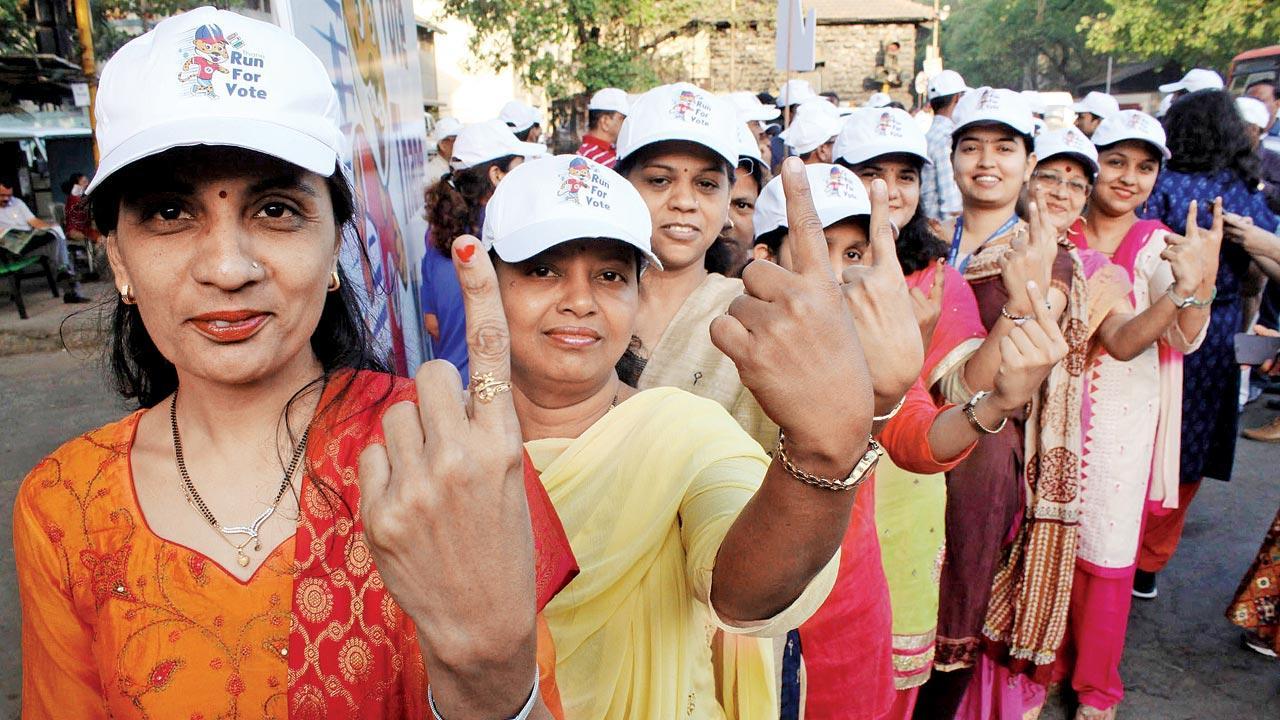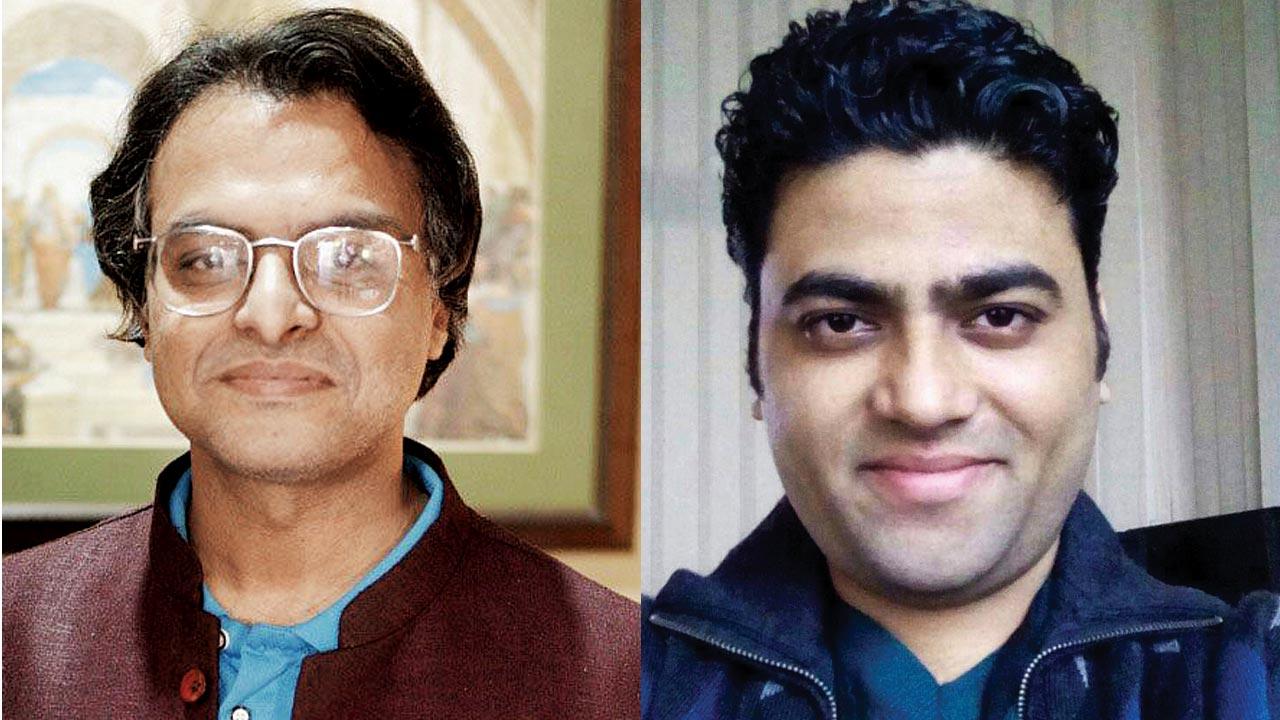Two academics take a closer look at India’s electoral data to find truths that have for long eluded us

Mumbai voters participate in a campaign to create awareness among the residents to cast their vote during the 2019 Lok Sabha elections. Pic/Getty Images
The Indian voter is a fascinating subject. Economist Arun Kumar Kaushik and psephologist Yugank Goyal will tell you this. “Voters are very cognisant of whom they want in Delhi and which party in the state,” explains Goyal. He cites the example of the 2017 Vidhan Sabha elections in Himachal Pradesh, where almost 42 per cent people voted for the Congress. “But in the Lok Sabha elections that took place two years later, only 27 per cent voted for the party. So this idea of the Indian voter being gullible is not really true. They truly know what they want.”
ADVERTISEMENT
In their just-released book, Who Moved My Vote? (Westland Non-fiction), the academics sift through electoral data, to explore why the complex number game sometimes leaves the discerning voter disheartened and with a leader and party they never voted for. Pointing out leakages in the system, the duo also makes a case for the need for reforms in the election machinery.
Edited excerpts from the interview
In the book, you state that the “Majority does not win [in the Indian elections]. Plurality does”. Could you explain?
Yugank Goyal: Technically, you win by a majority, if you have more than 50 per cent voters supporting you. But in India, even if you don’t have 50 per cent votes or seats, you can form the government with the help of others. This means that a majority of the people didn’t even vote you to power. So, while we think we are run by a majority rule, the reality is hardly so. This is exactly what happened in the Maharashtra Assembly elections of 2019.
Arun Kumar Kaushik: Another interesting example is the Karnataka Assembly elections [of 2018], where HD Kumaraswamy’s [Janata Dal (Secular)] emerged as the third largest party with 16 per cent votes, and still went on to form the government with the Congress. BJP with 40-plus per cent seats [104 seats] failed to do so.

Yugank Goyal and Arun Kumar Kaushik
There have been accusations of the Indian elections being rigged, and EVMs tampered.
YG: To be honest, without [on-ground] data, it’s difficult to say if rigging really happens. Although by and large, India has had an impressive record of conducting elections peacefully since independence. More than rigging, it is micro-level influencing that surely has increased. With the use of EVMs though, you now have access to booth-level data, which was not the case with ballot boxes. Because of this, you know whether you have won or lost in a booth. This is interesting, as the local leaders and workers, who understand the caste-gender dynamics at the booth-level, would then have an idea of which mohalla didn’t vote for them. Based on this data, they can invest resources in a more targeted manner to influence the specific mohallas.... this also [creates] a level-playing field.
Has the None of the above (NOTA) option, ever made a dent in the vote share of parties in the elections?
AKK: There are legal constraints to NOTA. Even if a majority opt for it, you cannot choose a NOTA government. It’s just a tool or rather, power given to citizens to express their dissent. But it can be used by political parties to dilute voter preferences, and though, there’s no straightforward answer to this, NOTA has impacted some results in the past.
YG: In the 2014 Lok Sabha elections, for instance, A Raja, who was accused in the 2G scam, contested from the Nilgiris constituency. He lost by a huge margin, and NOTA was the third highest vote grosser there. In Gujarat, Karnataka, Madhya Pradesh and Rajasthan, there have been several instances, where NOTA votes, were larger than the difference in the winners and losers. In Karnataka, NOTA votes were higher than the votes received by six parties, including national parties like CPI(M) and BSP! In MP, NOTA’s vote share was 1.4 per cent, even though the vote share difference between the top two parties (Congress and BJP) was merely 0.1 per cent.
What kind of reforms do you hope to see in India’s election process?
AKK: Different democracies have adopted different types of electoral methods to build a fairer system of preference aggregation. Australia and Ireland, for instance, get their citizens to rank the candidates, rather than just select one of them. Despite its wide prevalence, including in India for electing our president, there is little that people know about it. A method known as instant runoff method is perhaps a better method. It brings the candidate who is least hated, rather than the candidate who is most loved.
You say that Congress did not have unwavering support across the country, even during its heydays.
YG: You’d be surprised to know that in the first-ever elections [1951], the second largest votes really went to the Independents. In fact until 1967, every time Congress came to power with a vote share lying between 40 and 47 per cent. This means the majority of Indians did not vote for them.
AKK: Even in 1984, when Congress was the most dominant party—it got the maximum number of seats [414]—the difference between the votes [48.1 per cent] and seats share [78 per cent], was 30 per cent. This effectively means that Congress was still ruling 30 per cent of the people who didn’t vote for them.
It’s speculated that Indians do not vote as much on party lines, as they do for the face of the party.
YG: That’s a likelihood. If people are ideologically committed to a certain party, they’d want that party to rule in both the state and the Centre. But, if you look at India’s electoral history, that has not always happened. This is just a speculation that I can make, but the way the Conservatives and Republicans work in the US—they are very close to their party ideologies. Parties in India don’t operate within such watertight ideological compartments. BJP has implemented liberal-welfare policies, and Congress too, has taken many conservative decisions. Things are quite fluid here. And if it’s fluid, who would people vote for?
 Subscribe today by clicking the link and stay updated with the latest news!" Click here!
Subscribe today by clicking the link and stay updated with the latest news!" Click here!







